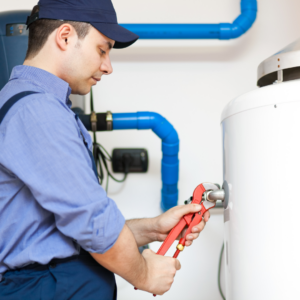A functional water heater is essential to maintain the comfort of a home. Unfortunately, water heaters rarely alert homeowners to their impending failure. When a water heater is on the brink of going out, some signs can alert homeowners of the issue. This article will discuss some symptoms and how to prevent water heater failure.

What are the signs that your water heater is going out?
The first sign of a failing water heater is a lack of hot water. If a home’s hot water supply is decreasing or ceasing, it could indicate that the water heater is going out. When a water heater reaches the end of its life, it will struggle to heat the water, and eventually, it will be unable to do so.
Another sign of a failing water heater is a significant increase in water bills. As a water heater begins to fail, it will become less efficient and begin to use more energy to heat water. This will cause an increase in the monthly water bills.
Noises from the water heater can also be a sign of impending failure. If the heater is making loud noises or banging noises, this is a sign that the system has reached the end of its life and needs to be replaced.
Sometimes, water heaters will start to leak. As the system ages, the internal components will begin to rust, leading to weak points that can cause a leak. Additionally, the pressure-relief valve can sometimes fail, which can cause a leak due to excessive pressure in the tank.
Finally, if a water heater is over 10-15 years old, it will likely need replacement. Water heaters should be replaced every 10-15 years to prevent the system from completely failing.
Preventing water heater failure is essential for homeowners. To keep their water heater running efficiently and for as long as possible, homeowners should perform regular maintenance on the system. This includes flushing the tank to remove the sediment buildup, checking the temperature pressure-relief valve, and checking the anode rod. Additionally, homeowners should inspect their water heaters regularly for any signs of damage or corrosion.
In conclusion, a failing water heater can be very inconvenient and costly. By knowing the signs of a failing water heater, homeowners can replace their system promptly and avoid more expensive repairs. Additionally, regular maintenance on a water heater can help extend its life.
 Home Insurance Renewal Inspections in Irvine: What Homeowners Should KnowMarch 31, 2025 - 12:51 pm
Home Insurance Renewal Inspections in Irvine: What Homeowners Should KnowMarch 31, 2025 - 12:51 pm Newport Beach Home Insurance Renewal Inspections: Avoid These Common IssuesMarch 29, 2025 - 11:14 am
Newport Beach Home Insurance Renewal Inspections: Avoid These Common IssuesMarch 29, 2025 - 11:14 am Home Insurance Renewal Inspection in Orange County: What You Need to KnowMarch 20, 2025 - 8:14 am
Home Insurance Renewal Inspection in Orange County: What You Need to KnowMarch 20, 2025 - 8:14 am Who Hires the Home Inspector When Buying a House?March 5, 2025 - 8:16 am
Who Hires the Home Inspector When Buying a House?March 5, 2025 - 8:16 am


